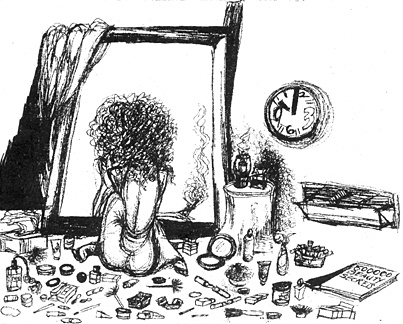All Nonfiction
- Bullying
- Books
- Academic
- Author Interviews
- Celebrity interviews
- College Articles
- College Essays
- Educator of the Year
- Heroes
- Interviews
- Memoir
- Personal Experience
- Sports
- Travel & Culture
All Opinions
- Bullying
- Current Events / Politics
- Discrimination
- Drugs / Alcohol / Smoking
- Entertainment / Celebrities
- Environment
- Love / Relationships
- Movies / Music / TV
- Pop Culture / Trends
- School / College
- Social Issues / Civics
- Spirituality / Religion
- Sports / Hobbies
All Hot Topics
- Bullying
- Community Service
- Environment
- Health
- Letters to the Editor
- Pride & Prejudice
- What Matters
- Back
Summer Guide
- Program Links
- Program Reviews
- Back
College Guide
- College Links
- College Reviews
- College Essays
- College Articles
- Back
How the World See's the Skeleton Goddess
Media glorifies unhealthy body images. Fashion advertisers are unintentionally supporting anorexia and bulimia by featuring stick-like models in their ads. Research shows that 69% of girls in the 5th - 12th grade have reported that magazine pictures do in fact influence their idea of a perfect body. Featuring models that don’t fit the criteria for anorexia and bulimia will change how every young boy and girl interprets the word beauty.
Advertisers force us to question what beauty is and how we can change ourselves to achieve perfection. The average fashion model weighs 23% less than the average female. Studies have found that women who look through magazines with extremely thin models feel insecure about their own appearance. The problem with anorexic models in advertising is that it pressures young boys and girls to be skinny. I think why anorexic models in advertising has such a great influence in eating disorders is because we can’t alter our bodies like editors can with photoshop, instead we alter it through starvation.
Some people might argue that media and advertising are not to blame for anorexia or any other eating disorder. Some psychologists say eating disorders originate from the inside not outside, of the home. However, seeing excessive amounts of advertisements featuring incredibly thin models can trigger thoughts of dieting. When we see advertisements with young, skinny, and happy models we’re manipulated into thinking we need that companies product to be satisfied with our bodies and lives. What can over all cause an eating disorder is the feeling of inadequacy due to constantly being compared to an unrealistic ideal.
Studies have found that 56% of television commercials targeted at female viewers used beauty as a product appeal. Research has shown that the number one wish for girls ages 11-17 is to be skinnier. The question everyone asks is why? I personally have felt insecure about my own body weight. It’s extremely hard to pinpoint exactly when i started experiencing thoughts of dieting. However, i do know social media and advertising helped motivate me to achieve my ideal weight. I would frequently compare myself to overly thin fashion models to help motivate me not to eat. Even though there are many different reasons why people develop eating disorders, advertising does influence their idea of beauty.
The average woman sees 400-600 advertisements per day. 9% of those advertisements give a direct statement about beauty. We as consumers have no escape from advertisers influence on modern society. Media persuades us to question what beauty really is and how we can change ourselves to achieve societies distorted view of perfection. The truth of the matter is that self-acceptance is knowing that theres more to life than looking a certain way. Our founding fathers stood for the principles of life, liberty, and the pursuit of realistic happiness. Its time that advertisers learn what realistic happiness really means.

Similar Articles
JOIN THE DISCUSSION
This article has 0 comments.
